Cette semaine nous partons à la rencontre de l’artiste londonienne, Katy Papineau.
Artiste figurative, Katy compose des narrations fortes de symboles qui lui sont chers et personnels et nourris par de multitudes influences artistiques et littéraires.
Depuis petite, la lecture a le pouvoir d’éveiller l’imagination de Katy et de lui dicter de multiples histoires dont elle ressent la nécessité de les transposer sur toile ou sur papier. Dès lors, l’artiste crée des œuvres de petites dimensions mais immenses par leurs pouvoirs à nous transporter dans des univers singuliers où notre œil est sans cesse défié tant par la quantité d’éléments à admirer que par ses multiples références.
Par sa vitalité de la touche, son emploi de couleurs expressives, son attention portée aux motifs et aux détails, l’artiste nous emmène dans une réalité enchantée. Entre conte et réalité, l’œuvre de Katy fascine.
Avec Katy nous avons échangé sur ses principales influences, sur son processus créatif et sur l’évolution de son travail, récemment bouleversé par le dernier confinement qui a eu un réel impact sur ses envies créatrices.
Artiste figurative, Katy compose des narrations fortes de symboles qui lui sont chers et personnels et nourris par de multitudes influences artistiques et littéraires.
Depuis petite, la lecture a le pouvoir d’éveiller l’imagination de Katy et de lui dicter de multiples histoires dont elle ressent la nécessité de les transposer sur toile ou sur papier. Dès lors, l’artiste crée des œuvres de petites dimensions mais immenses par leurs pouvoirs à nous transporter dans des univers singuliers où notre œil est sans cesse défié tant par la quantité d’éléments à admirer que par ses multiples références.
Par sa vitalité de la touche, son emploi de couleurs expressives, son attention portée aux motifs et aux détails, l’artiste nous emmène dans une réalité enchantée. Entre conte et réalité, l’œuvre de Katy fascine.
Avec Katy nous avons échangé sur ses principales influences, sur son processus créatif et sur l’évolution de son travail, récemment bouleversé par le dernier confinement qui a eu un réel impact sur ses envies créatrices.
L'artiste Katy Papineau devant ses oeuvres
Could you introduce yourself?
Hello! I’m Katy, I’m a figurative artist and I live in London, which is also where I grew up. At the moment I’m particularly interested in domestic spaces, decoration and everyday life.
Poetry, stories, literature in general influence your work. Could you tell us about it ?
The role of literature in my work used to be quite direct. I would read a story and make a painting representing the images that it sparked in my imagination. But the relationship between my paintings and literature has become more oblique over the last couple of years, as I’ve gradually developed my own symbols. I spent last year reading a lot of fairy tales and some of the symbols from those stories (for example mirrors, or the colour red) have really stuck with me and make appearances in my paintings. But now those symbols represent something multi-layered and personal, rather than a direct translation from the original story.
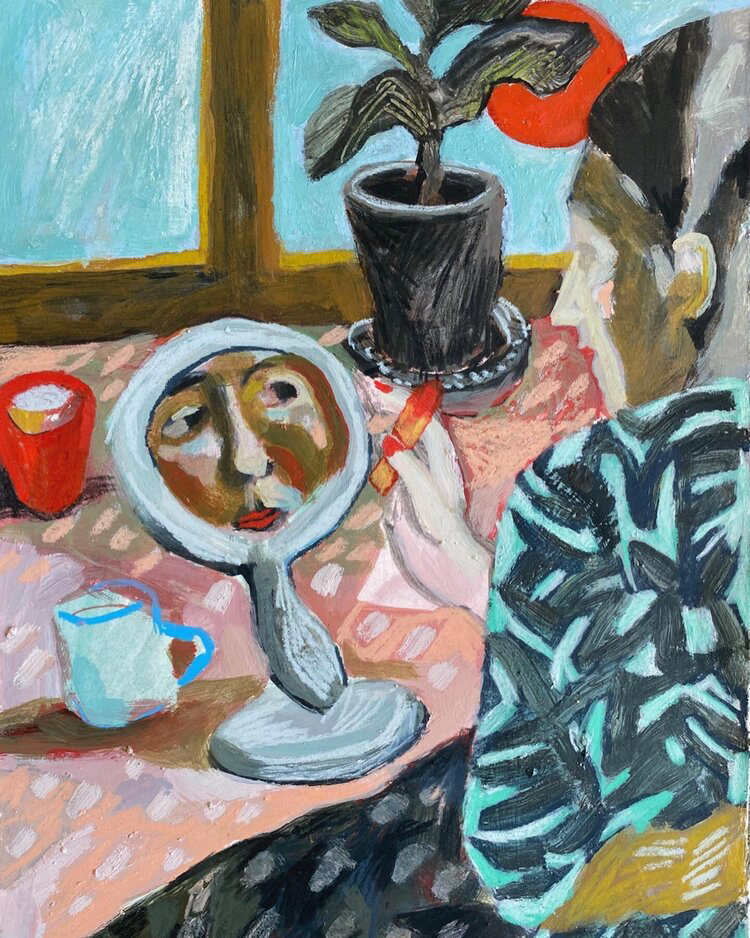
Putting on a Face I, 2020, 35.5cm x 25.5cm, Pigment, pencil and crayon on Canaletto paper
You also create many everyday scenes, but the colours you use bring a dreamlike dimension. Are they imaginary scenes?
It depends! I don’t paint purely from imagination, I always use some sort of visual reference. But there is a strong element of imagination in my paintings, otherwise I would get bored. The colours I use are mostly imagined - I tend to be more interested in colour relationships I can manipulate on the page than in the colours I see in the world around me.
You paint many portraits but in your interior scenes we notice that you don’t draw precisely the features of your characters. Could you speak about your interest for the domestic interiors ?
When the March lockdown began in the UK, like most people, I was spending virtually all my time indoors, working, eating and living in the same room. I started looking a lot at the Nabis and the quiet, decorative nature of their work felt exactly suited to my state of mind. It had a really transformative effect on my work and ever since then I’ve been preoccupied with depicting people in their homes. I like thinking about how we choose to influence the spaces around us, and how those spaces can influence us in turn.
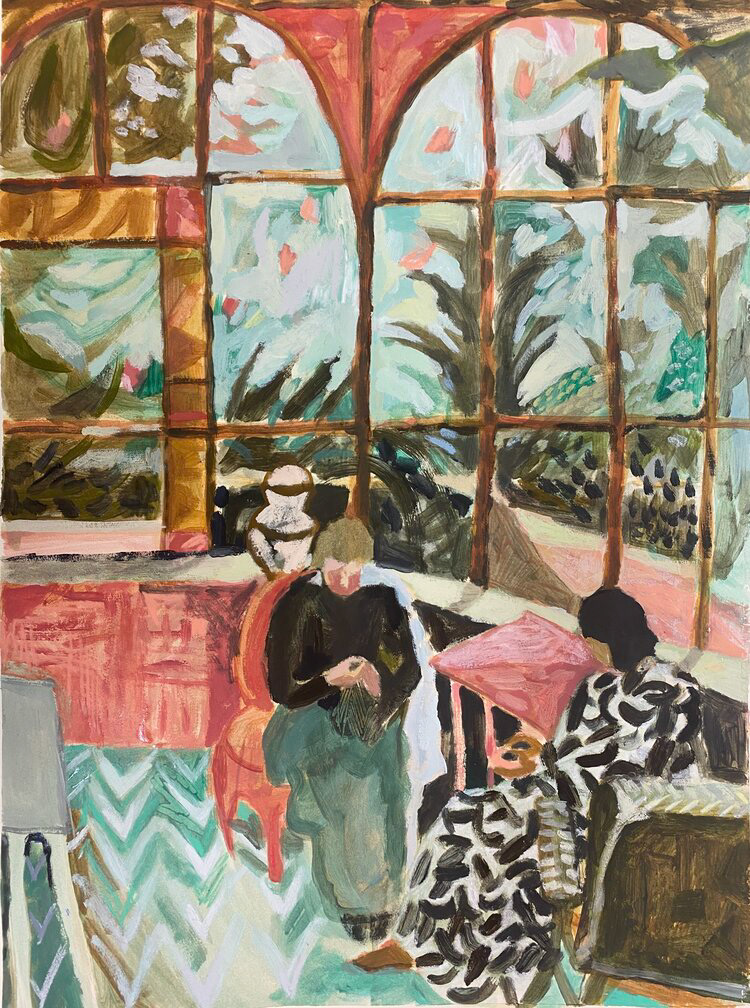
Commission, 2020, 50cm x 70cm
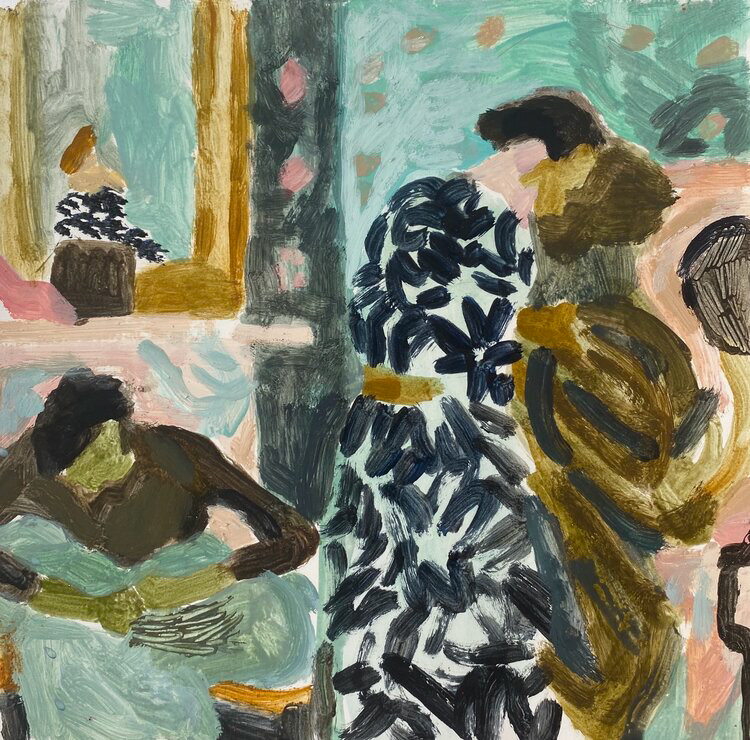
After Vuillard and it’s a study of Vuillard’s ‘The Flowered Dress’ in dry pigment with gouache medium, 2020
The pattern seems very present in your work, the lines and the colors mingle sometimes to an unity. Could you speak a bit about it ?
The patterns partly come from looking so much at Vuillard and his use of pattern, and partly because I’m interested in mark-making. I am striving to make paintings in which colour and line combine to create areas of discord and harmony. By introducing pattern I want the viewer’s eye to be stimulated by the varied energy and direction of marks on the surface of the painting.
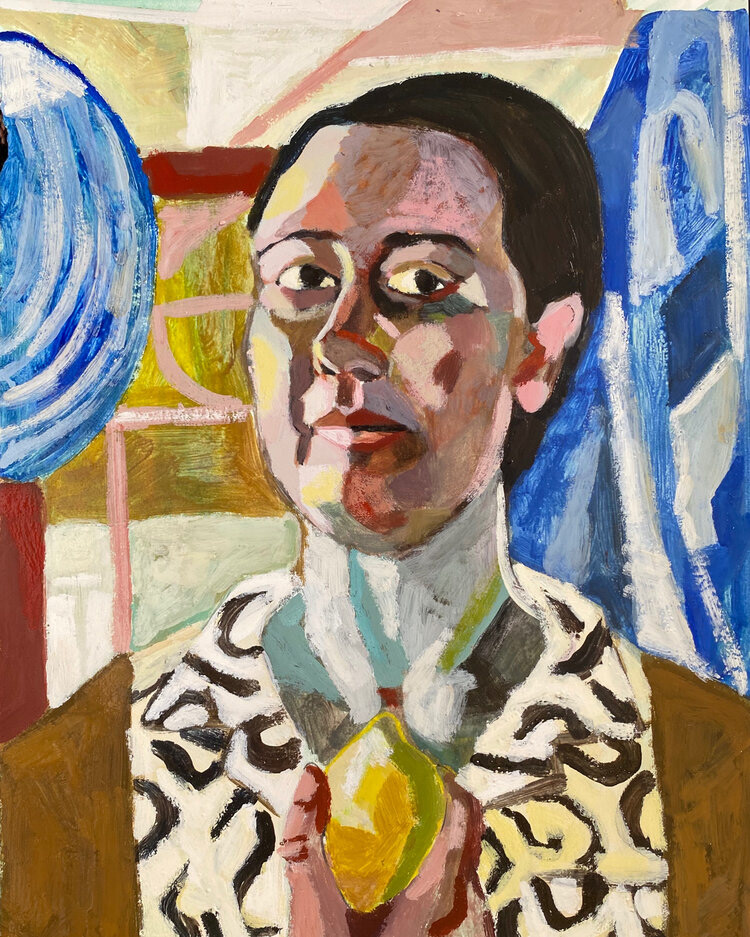
Painting inspired by Paula Modersohn-Becker’s Self-Portrait with Lemon - pigment with watercolour medium on Canaletto paper, 2020
Could you tell us about your creative process?
I usually start with a visual reference. What I’m currently reading or the themes I’m thinking about will guide the visual inspiration I seek out. Sometimes the inspiration for a painting will be a fragment of a painting from art history or a film still. Sometimes it will be a sketch I’ve drawn from life or a photograph I’ve taken. In my studio, I do several sketches to establish my composition (often combining multiple reference images), including an abstract colour sketch of the colour combinations I will use. Then I work on a bigger painting, with all the sketches by my side for reference.
Paula Rego's narrative and Vuillard's motifs seem to be present in your work. The Art History in general seems important to you. Could you tell us about your inspirations?
When I first started painting, the things I found most challenging were colour and composition. I’ve found that regularly drawing from art history has helped me develop a muscle memory for how to construct an image with a composition and colour palette that feel authentically personal. If I ever feel stuck, doing a study from a painting I find absorbing gets me out of that rut. Rego and Vuillard have been important companions to my work at different points, and I’m always collecting references from a wide range of artists and time periods. I usually have four or five Pinterest boards on the go, where I pin paintings relevant to a particular theme I’m thinking about.
Do you have any future projects to share with us?
I’m hoping to set up my online shop in the next few months – I’ve been working on a collection of textile & wallpaper designs which I’m really excited about. I’m also working on plans for a series of giclée prints. I’ve recently moved into a new studio which has given me a bit more freedom in the type of work I make (up until now I’ve mainly been painting on paper) and so I’m currently working a series of oil paintings. Hopefully when restrictions ease again I’ll be able to do an open studio and show them in person. And I usually work on one or two painting commissions per month, so I’ll hopefully continue doing that too!
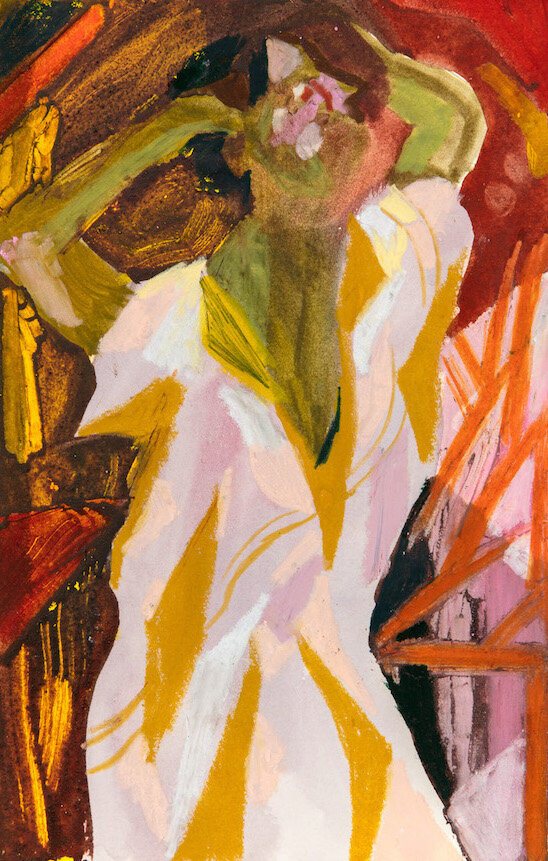
Where’s My Hair Tie ? 2019, Pigment, pencil, oil pastel.
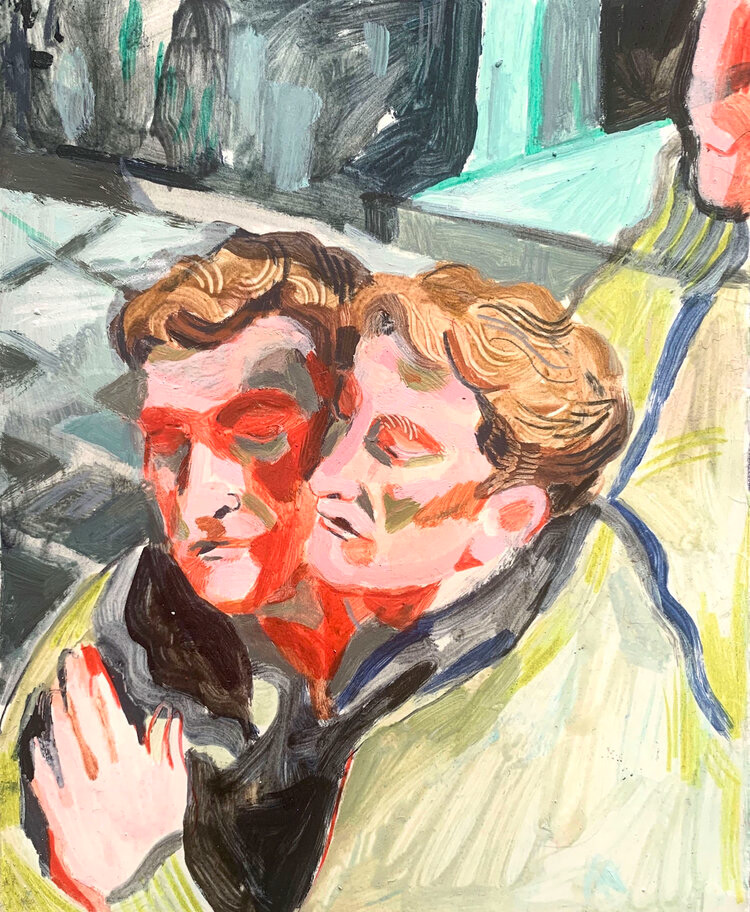
“Orphée, After Cocteau”, 2020, Pigment and coloured pencil, 25cm x 20cm
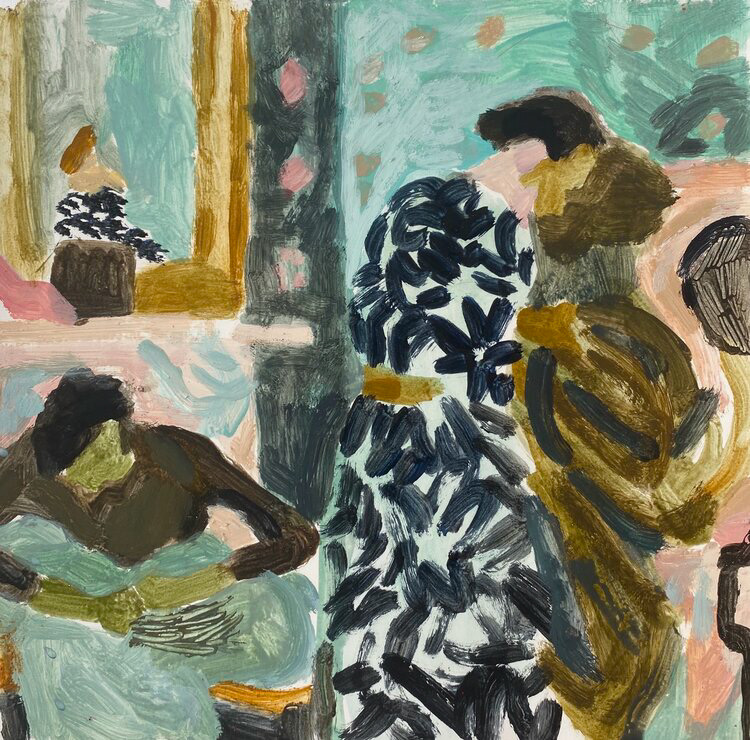
After Vuillard and it’s a study of Vuillard’s ‘The Flowered Dress’ in dry pigment with gouache medium, 2020
Pour poursuivre la découverte des oeuvres de l'artiste je vous invite à la suivre sur son compte Instagram :
Et à vous rendre sur son site web :
https://katypapineau.com